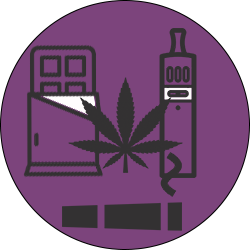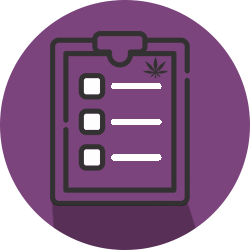Cannabis use (non-medical) in Canada: Health Infobase
- Last updated: 2024-01-12
Key findings on non-medical use of cannabis in Canada in 2023.
Data over the past 6 years
The Cannabis Act came into force on October 17, 2018 and provides legal, restricted access to cannabis and controls and regulates its production, distribution and sale. To help evaluate the impact of the legalization and regulation of cannabis, Health Canada has been conducting the annual Canadian Cannabis Survey (CCS) since 2018 to better understand how Canadians view and use cannabis. This data blog presents data from the past 6 years of the CCS. The 2018 cycle was conducted pre-legalization and the other 5 cycles were conducted post-legalization. To document changes over time, comparisons to 2018 are presented; in cases where a question was added after 2018, comparisons are made to the first year the question was asked. Findings are also compared to the previous survey cycle (2022)Footnote 1Footnote 2. Key findings on cannabis use for non-medical purposes from 2018, 2019, 2020, 2021, 2022 and 2023 are presented to examine self-reported changes since legalization and regulationFootnote 1Footnote 2. All results refer to cannabis use for non-medical purposes among Canadians aged 16 years and older.

Cannabis use
More than a quarter of Canadians reported cannabis use in the past 12 monthsFootnote 3
- Past 12-month cannabis use in 2023 (26%) increased from 2018 (22%).
Approximately 1 in 6 Canadians reported cannabis use in the past 30 daysFootnote 3
- Past 30-day cannabis use increased from 15% in 2018 to 17% in 2023, and decreased from 19% in 2022 to 17% in 2023.
- In 2023, past 30-day use remained higher among males (19%, unchanged from 19% in 2018) than among females (15%, an increase from 11% in 2018).
- In 2023, past 30-day use remained higher among Canadians aged 16-19 years (29%, an increase from 23% in 2018) and 20-24 years (31%, unchanged from 30% in 2018) than among people age 25+ (15%, an increase from 13% in 2018).
Frequency of daily or almost daily cannabis use remained unchanged
- Six percent (6%) of all Canadians reported using cannabis daily or almost daily, unchanged from 5% in 2018 and a decrease from 7% in 2022.
- This represented 23% of Canadians who reported using cannabis in the past 12 months, unchanged from 25% in both 2018 and 2022.
- In 2023, daily/almost daily use remained higher among males (7%, unchanged from 7% in 2018) than among females (5%, an increase from 4% in 2018).
- In 2023 daily/almost daily use remained higher among Canadians aged 16-19 years (9%, unchanged from 7% in 2018) and 20-24 years (11%, unchanged from 12% in 2018) than among people age 25+ (5.3%, an increase from 4.6% in 2018).
While cannabis smoking decreased, it remained the most common consumption method
- Smoking cannabis decreased from 89% in 2018 and 70% in 2022 to 63% in 2023.
- Eating/drinking cannabis increased from 43% in 2018 to 55% in 2023 and remained stable between 2022 and 2023.
- Vaping cannabis (including vaping dried cannabis and/or liquid or solid cannabis extracts) was unchanged between 2018 and 2023 and decreased between 2022 (36%) and 2023 (33%).

Cannabis sourcing
More Canadians purchased cannabis from a legal source
- In 2023, 73% of those who reported using cannabis in the past 12 months reported usually purchasing their cannabis from a legal source (storefront or website), an increase from 4% in 2018 and 69% in 2022.
- This included 67% who reported purchasing from a legal storefront (up from 61% in 2022) and 5% who reported purchasing from a legal website (down from 8% in 2022).
- Fifteen percent (15%) of people reported obtaining their cannabis from a social source (shared around a group of friends, from a friend, family member or acquaintance), a decrease from 2018 (60%) and 2022 (18%).
- Five percent (5%) reported growing their own cannabis or having it specifically grown for them, a decrease from 2018 (7%) and 2022 (8%).
- Only 3% of people reported purchasing from an illegal source (illegal store, illegal website or dealer), down from 2018 (28%) and unchanged from 2022 (4%).
- Two percent (2%) reported getting their cannabis from a storefront located in a First Nations community (new in 2023).
Average monthly spending on cannabis in the past 12 months decreased since 2018
- The amount typically spent per month on cannabis decreased from $73 in 2018 to $63 in 2023 and was unchanged between 2022 ($65) and 2023 ($63).

Knowledge and attitudes
Canadians who had used cannabis are more likely to believe it can be habit-forming but less likely to endorse other risks
- Approximately 7 out of 10 (69%) Canadians reported ‘somewhat’ or ‘strongly’ agreeing that they had enough trustworthy information about the health risks of cannabis use to make informed decisions, a decrease compared to both 2019 and 2022 (71% and 72%, respectively). Those who had used cannabis in the past 12 months were more likely to agree (84%) than those who had not (63%).
- In 2023, the majority (90%) of Canadians believed that cannabis use can be habit-forming, an increase from 82% in 2018 and unchanged from 2022 (89%). This was more common among those who had used cannabis in the past 12 months (92%) than those who had not (89%).
- The majority of Canadians (87%) reported that it is not okay to use cannabis while pregnant or breastfeeding, a decrease from 2019 (98%) but unchanged from 2022 (86%). This was more common among those who had not used cannabis in the past 12 months (88%) than those who had (83%).
- Just under 7 in 10 (68%) Canadians believed that daily or almost daily cannabis use increases the risk of mental health problems, a decrease from 2019 (89%) but up from 2022 (66%). This was more common among those who had not used cannabis in the past 12 months (70%) than those who had (61%).
Perception that smoking and vaping cannabis regularly carries moderate or great risk has increased since 2018
- Compared to 2018, perceived ‘moderate’ or ‘great’ risk increased for smoking cannabis (75%, up from 72%) and vaping* cannabis (78%, up from 70%).
- Perceived moderate or great risk of eating/drinking cannabis decreased compared to 2018 (63%, down from 66%).
- Among those who had not used cannabis in the past 12 months, a greater percentage perceived ‘moderate’ or ‘great’ risk from regularly smoking (81% vs. 57%), vaping dried cannabis (81% vs. 60%), vaping cannabis extracts (78% vs. 55%), or eating/drinking cannabis (72% vs. 36%) compared to those who had used cannabis (Figure 4).
* In 2023, vaping cannabis combines responses from two questions on vaping dried cannabis (72%) and liquid/solid cannabis extracts (75%).
Explore the data in Figure 4
Driving and cannabis use
Fewer people operated a vehicle after cannabis use in the past 12 monthsFootnote 4
- Seventeen percent (17%) of people who had used cannabis in the past 12 months reported driving after cannabis use, a decrease from 27% in 2018.
- This included 12% who reported driving within 2 hours of smoking or vapourizing cannabis and 8% who reported driving within 4 hours of ingesting cannabis in the past 12 months.
- In 2023, rates were higher among males than females (19% vs. 14%, respectively) but did not differ by age group.
In 2023, 86% of Canadians believed that cannabis use impairs one's ability to drive
- Among those who have used cannabis in the past 12 months, 79% felt that cannabis use impairs one’s ability to drive, 13% responded that it depends, and 5% responded that it did not impair one’s ability to drive.
Approximately a quarter (24%) of Canadians believe it is ‘extremely likely’ or ‘likely’ that a driver would be caught driving under the influence of cannabis.
- An additional 37% believe a driver is ‘somewhat likely’ to be caught driving under the influence of cannabis, down from 2018 and 2022 (40% and 39%, respectively).
- Those who used cannabis in the past 12 months were less likely to believe it is ‘extremely likely’ or ‘likely’ that a driver would be caught driving under the influence of cannabis than people who had not used cannabis (20% and 26%, respectively).
Suggested citation
Canadian Cannabis Survey. Cannabis use for non-medical purposes among Canadians (aged 16+). Ottawa: Health Canada; January 2024.
For more information about cannabis
You might also be interested in
Sentinel Surveillance of Substance Use-related Injuries and Poisonings in Canada
Statistics on substance use-related injuries and poisonings reported by the Canadian Hospitals Injury Reporting and Prevention Program.
Canadian Postsecondary Education Alcohol and Drug Use Survey, 2019/2020
Detailed information on patterns of substance use among postsecondary students in Canada, and the impacts that substance use is having on their lives.
- Date modified:
